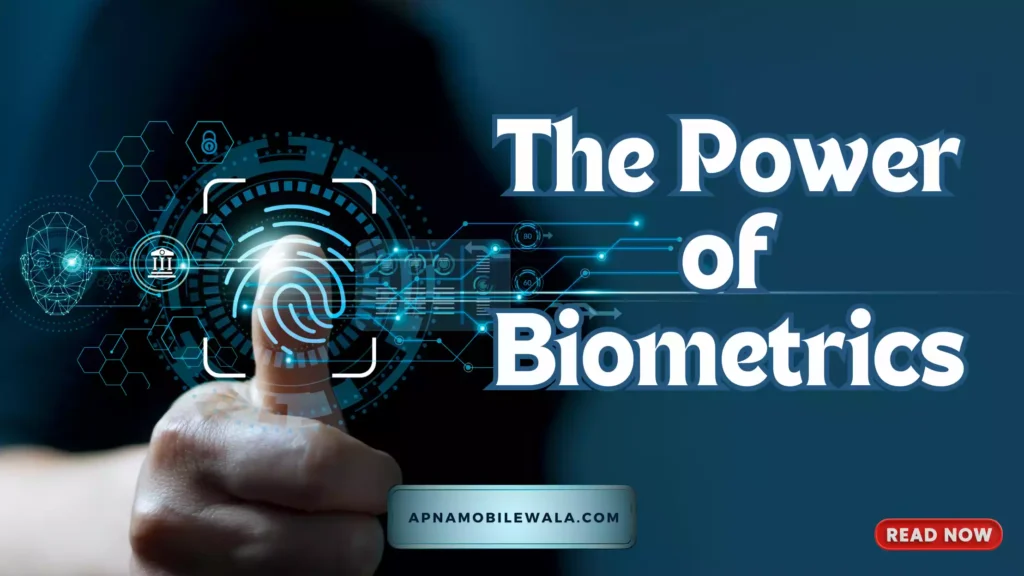The Sixth Sense in Your Pocket: Biometric Authentication and the Future of Phone Security
Remember that scene in “Minority Report” where Tom Cruise unlocks a door with his iris? That futuristic world of biometric authentication is no longer science fiction. Fingerprint scanners, facial recognition, and even voice recognition are now commonplace features on our smartphones, offering a new level of security and convenience.
But are biometrics the key to a truly secure mobile future? Let’s delve into this powerful technology and explore what it holds for our phones.
The Power of Biometrics:
Biometric authentication relies on our unique physical or behavioural characteristics to verify our identity. Fingerprints, iris patterns, facial features, and even voice patterns all act as personal signatures that phones can use to confirm it’s the rightful owner trying to gain access.
Convenience at Your Fingertip (Literally):
Compared to traditional passwords or PINs, biometrics offer a smoother user experience. No more struggling to remember complex codes – a quick fingerprint scan or a glance at the camera can unlock your phone instantly.
Enhanced Security:
Biometrics are generally considered more secure than passwords. They’re unique to each individual and much harder to forge or steal compared to a code someone could potentially guess or overhear.
A Glimpse into the Future:
Biometric technology is constantly evolving. Iris scanners are becoming more sophisticated, and voice recognition is reaching new levels of accuracy. We might even see advancements like vein recognition or gait analysis used for phone security in the coming years.
Not a Silver Bullet: While biometrics offer significant advantages, they’re not without limitations. Fingerprint scanners can be fooled by smudges or injuries, and facial recognition can be susceptible to high-quality photos or deepfakes. Security remains an ongoing battle, and new methods to bypass biometric authentication are constantly emerging.
The Privacy Balancing Act:
Biometric data is highly personal, and its storage and use raise privacy concerns. Who has access to this data? How secure is it stored? These are crucial questions that need to be addressed as biometric technology becomes more prevalent.
The Future of Security – A Multi-layered Approach:
It’s likely that future phone security will rely on a multi-layered approach. Biometrics will likely remain a core component, but it might be combined with other methods like strong passcodes or two-factor authentication for an extra layer of protection.
Biometric authentication offers a glimpse into a future where our phones unlock with the touch of a finger or a glance at the screen. However, it’s important to acknowledge the limitations and prioritize privacy as this technology continues to evolve. The “sixth sense” in our pocket is a powerful tool, but like any powerful tool, it needs to be used responsibly.
What is Biometric Authentication in Mobile
Biometric authentication on mobile phones is a security system that uses your unique biological characteristics to verify your identity and grant access to your device. Instead of relying on passwords or PINs, which can be forgotten or stolen, biometrics leverage traits like fingerprints, facial features, or even your voice to confirm it’s you trying to unlock your phone.
Here’s a breakdown of how it works:
- Types of Biometrics: There are several biometric technologies used in mobile phones:
- Fingerprint Recognition: This is the most common method, using a sensor to scan your unique fingerprint pattern.
- Facial Recognition: The phone’s camera captures your face and compares it to a stored image for verification.
- Voice Recognition: Your voice patterns are analyzed to identify you based on unique vocal characteristics.
- Other Methods: Less common options include iris scanners (reading your iris pattern) or even vein recognition (using the vein patterns in your finger).
- Convenience and Security: Biometrics offer a smoother user experience compared to passwords or PINs. No more struggling to remember complex codes – a quick fingerprint scan or a glance at the camera can unlock your phone instantly. Additionally, biometrics are generally considered more secure as they’re unique to each person and harder to forge or steal than a password.
- Limitations: While convenient and secure, biometrics aren’t foolproof. Fingerprint scanners can be fooled by smudges or injuries, and facial recognition can be susceptible to high-quality photos or deepfakes (realistic AI-generated videos). Security is an ongoing battle, and new methods to bypass biometric authentication are constantly emerging.
- Privacy Concerns: Biometric data is highly personal, raising concerns about how it’s stored and used. Who has access to this data? How secure is it? These are crucial questions that need to be addressed as biometric technology becomes more prevalent.
Overall, biometric authentication is a powerful tool that offers a more secure and convenient way to unlock your phone. However, it’s important to be aware of the limitations and prioritize privacy as this technology continues to evolve.
Mobile App Biometric Authentication
Mobile app biometric authentication leverages your unique biological characteristics to access specific functions within an app, rather than just unlocking your phone itself. Here’s how it works:
Types of Biometric App Logins: Similar to phone unlocking, apps can utilize various biometric methods:
- Fingerprint Scanners: Many apps allow fingerprint logins for secure access to sensitive information or functionalities within the app itself.
- Facial Recognition: Some apps might use facial recognition for secure login or verification, especially for financial transactions or access to confidential data.
- Voice Recognition: While less common, voice recognition could be used for app logins in specific scenarios, like authorizing voice purchases or accessing voice-controlled features.
Benefits of Biometric App Logins:
- Enhanced Security: Biometrics add an extra layer of security compared to remembering multiple passwords for different apps. They’re harder to forge or steal, making it more difficult for unauthorized access.
- Convenience: Fingerprint scans or facial recognition are generally faster than entering usernames and passwords, offering a smoother user experience.
- Conditional Access: Biometrics can be used for specific actions within an app. Imagine needing a fingerprint scan to authorize a high-value money transfer or confirm identity before making a medical appointment.
Things to Consider:
- App-Specific Implementation: Not all apps offer biometric login options. It depends on the app developer’s choice and the level of security required for the app’s functionalities.
- Integration with Phone Security: Biometric app logins often rely on your phone’s existing biometric settings. If you haven’t enabled fingerprint or facial recognition for your phone unlock, you likely won’t be able to use them for apps either.
- Privacy Concerns: Similar to phone unlocking, biometric data used by apps raises privacy questions. Understanding how the app stores and uses this data is crucial. Look for apps with clear privacy policies that outline their data handling practices.
The Future of Mobile App Biometrics: As technology advances, we might see more sophisticated biometric options for mobile app authentication. Iris scanners or even vein recognition could potentially be integrated into future apps requiring the highest levels of security.
Mobile app biometric authentication offers a secure and convenient way to access sensitive information or functionalities within an app. However, it’s important to be aware of app-specific implementation, reliance on phone security settings, and potential privacy concerns.
Future of Phone Security
The future of phone security is likely to be a layered approach, combining different methods to create a robust defense against unauthorized access. Here are some exciting possibilities on the horizon:
Enhanced Biometrics:
Fingerprint scanners and facial recognition are likely to become even more sophisticated. Imagine iris scanners or vein recognition becoming mainstream for phone unlocking. However, advancements in spoofing techniques will necessitate continuous improvement in biometric security.
Behavioral Biometrics:
This emerging field analyzes how you interact with your phone – your typing style, how you hold the device, or your swiping patterns. These unique behavioural traits could be used as additional verification factors in the future.
Continuous Authentication:
Our phones might constantly monitor various factors (location, app usage patterns, etc.) to build a dynamic user profile. Deviations from this profile could trigger additional verification steps if suspicious activity is detected.
Hardware-based Security:
Phone manufacturers might integrate more secure hardware components like tamper-proof chips to store sensitive data and biometric information. This would make it even harder for hackers to steal this critical data.
The Rise of AI: Artificial intelligence could play a crucial role in future phone security. AI algorithms could analyze usage patterns, detect malware in real time, and predict potential security threats before they occur.
Focus on User Education:
No matter how advanced security features become, user education remains essential. Understanding best practices like strong password hygiene, avoiding suspicious links, and keeping software updated will continue to be crucial for robust mobile security.
Privacy Concerns:
With increased security measures come renewed concerns about user privacy. Striking a balance between robust security and user privacy control will be a major challenge as phone security evolves.
Here are some additional thoughts on the future:
- Multi-factor Authentication (MFA) will likely remain a cornerstone of phone security.
- Security features might become more context-aware, adapting to different situations. For example, requiring stronger verification when accessing financial apps on public Wi-Fi.
- The battle between security and convenience will likely continue. Phone security needs to be robust but not so cumbersome that it hinders user experience.
The future of phone security is all about creating a layered defense that protects our devices and data from evolving threats. It’s a continuous race between security researchers and those with malicious intent. By staying informed and using a combination of strong security practices and the latest features, we can keep our mobile experiences safe and secure.
Thanks for Reading!
- How Will We Access Virtual Worlds on Our Phones?
- The Rise of the Subscription Phone
- Sony Xperia 1 VI Price and Review
- Realme 12 Pro Plus Review and Price
- The Future of Mobile Gaming with AR, VR



